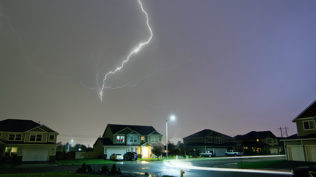Thunderstorms can develop rapidly and without warning – often accompanied by lightning. When thunderstorms form in your area and you hear thunder, you are likely within striking distance of the storm.
FACTS ABOUT LIGHTNING
According to the Insurance Information Institute:
- Between 2016-2018:
- An average of 83,991 lightning-related homeowner insurance claims were filed.
- The average cost per claim was $10,692.
- An average of $894 million was paid out for lightning-related homeowners claims.
- In 2018, the top five states for homeowner insurance lightning losses by number of claims were:
- Florida
- Georgia
- California
- Texas
- Louisiana
- The top four months for lightning incidents are:
- July
- August
- June
- May
Consider these tips to protect yourself and your property from lightning.
PROTECT YOURSELF
Before the storm:
- Plan ahead when going outside, so you can get to a safe place quickly if thunderstorms develop
- Move inside to a safe place if the sky looks threatening or you just don’t feel good about impending weather conditions.
- Know the weather patterns in your area and listen to the weather forecast for any outdoor area you plan to visit.
- Stay inside if there is a high chance of thunderstorms.
During the storm:
The only safe place during a thunderstorm is inside or in a safe shelter: “When the Thunder Roars, Go Indoors!” If you cannot get to a shelter, reduce the likelihood of being struck by lightning by following these tips:
- Avoid open fields or the tops of hills or ridges.
- Stay away from tall, isolated trees or other tall objects. If possible, stay near a lower stand of trees.
- Spread out if you are in a group; this can help prevent the current from traveling between group members.
- Remember that a tent offers no protection from lightning if you are in an open area.
- Stay away from water, wet items and metal objects.
Once you have sought shelter, avoid contact with corded phones, electrical equipment, plumbing, windows and doors because these items can become electrified if lightning strikes nearby.
After the storm
Wait 30 minutes after the last lightning or thunder before going back outside.
PROTECT YOUR HOME
To protect your home and possessions from damage or fire due to lightning, you may want to install a lightning protection system.
For the highest level of protection, the system should include:
- A lightning rod, connected to UL-listed copper or aluminum cable, to provide a conductive path for the electrical discharge to follow and disperse the energy safely into the ground.
- Electrical surge protection devices for incoming power, data and communication lines and for vulnerable appliances.
- Lightning protection for gas piping.
Remember that any lightning protection system should follow the national safety standards and requirements of the Lightning Protection Institute, National Fire Protection Association and Underwriters Laboratories.
To find a lightning contractor in your area, visit the Lightning Protection Institute at www.lightning.org
MORE INFORMATION
Learn more about lightning safety from the National Weather Service
Access the National Oceanic and Atmospheric Administration’s lightning safety brochure (PDF 2MB)
This loss control information is advisory only. The author assumes no responsibility for management or control of loss control activities. Not all exposures are identified in this article.

